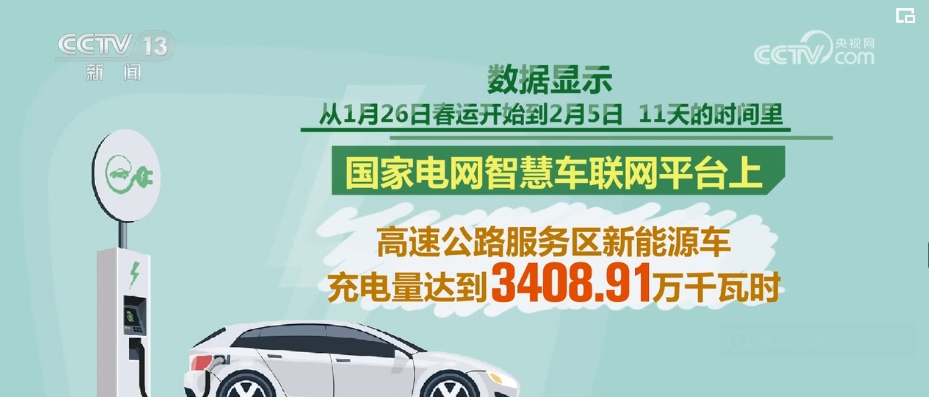Mobile charging car, emergency charging cabin … Accurate and scientific layout to alleviate the "charging tide"
CCTV News:In the past few days, many places in the country have ushered in the peak of returning home. According to the data of the smart car networking platform of the State Grid, as of February 5, the charging amount of new energy vehicles in the expressway service area on the platform has increased by more than 60% compared with the same period of last year. With more and more new energy vehicles joining the returning army, the "travel tide" has formed, and the "charging tide" of new energy vehicles has also appeared.

The data shows that in the 11 days from January 26th in Spring Festival travel rush to February 5th, the charging amount of new energy vehicles in the expressway service area reached 34,089,100 kWh, and the charging times reached 1,519,400, which were 67.06% and 48.42% higher than that in Spring Festival travel rush in 2023, respectively.

According to the platform data, during the Spring Festival travel rush in 2024, the peak period of the whole high-speed busy index reached 30%— 40%, which shows that among all the stations on the expressway, there are 30%— 40% of the stations are fully charged. At ordinary times, the charging busy degree of these stations is only about 10%, and the busy degree has doubled or tripled, showing an obvious tidal phenomenon.
Emergency charging compartment of mobile charging vehicle should deal with "charging tide"
In view of the "charging tide" brought by the "travel tide" of new energy vehicles, during the period of Spring Festival travel rush, many places in China took various measures to solve this problem.

It is predicted that during the Spring Festival in 2024, the average daily charging capacity of Jiangsu expressway service area will reach 600,000 kWh, a year-on-year increase of 70%, a record high. In order to alleviate the charging pressure, Taizhou power supply department has reformed 7 service areas and 14 charging stations within its jurisdiction, and equipped mobile charging vehicles. In Qinhu service area on Yanjing Expressway, a 120kW mobile charging vehicle is specially equipped, which can provide uninterrupted charging service for four electric vehicles at the same time.

In Pingwang Service Area, Wujiang District, Suzhou City, there are 16 charging parking spaces in the north-south direction. Since Spring Festival travel rush, affected by high-speed tidal phenomenon, eight charging parking spaces on the north side of the service area are basically full every day, but there are vacant parking spaces on the south side. Local staff guided some cars on the side with large traffic flow to the opposite idle service area for charging through the two-way culvert, which effectively improved the bearing capacity of the service area.

In Tianjin, in order to reduce the waiting time for new energy vehicle owners to charge on expressways, the local electric power department started the emergency charging cabin in the expressway service area on the one hand, and upgraded the charging facilities of 46 busy high-speed charging stations in advance. After the renovation, the average charging time was shortened by nearly 30%.
Scientific layout to ease the expressway "Charging tide"phenomenon
China has been speeding up the layout of charging piles, so that electric vehicles can alleviate the "energy-filling anxiety" of expressways. In the future, this phenomenon of "charging tide" is expected to be alleviated with the increasingly intelligent and efficient energy-replenishing network of expressways being gradually woven.

According to the data of the Ministry of Transport, at present, there are more than 20,000 charging piles in expressway service areas nationwide, covering nearly 50,000 parking spaces for minibuses. The coverage rate of charging facilities in expressway service areas in Beijing, Liaoning, Jilin, Shanghai, Zhejiang, Hunan and Xinjiang has reached 100%.

According to the data of China Electric Vehicle Charging Infrastructure Promotion Alliance, at present, the increment ratio of piles to vehicles is 1:2.5, and the construction of charging infrastructure can basically meet the rapid development of new energy vehicles. Experts say that highway charging piles are usually idle and not enough for holidays. To solve this "tidal" problem, we should not just consider the increment, but also improve the quality to ensure its economy.

In Liaoning, for new energy vehicle users, the local high-speed charging travel guide has been issued, so that drivers can check the layout of charging piles in advance, so as to better plan the charging line. At the same time, the local power department also accurately grasps the status of each charging pile, such as pile body, display and charging cable, through the digital platform, and problems can be solved in real time.